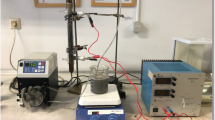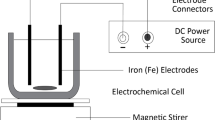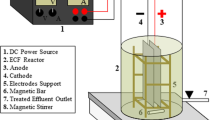Abstract
The large amount of municipal wastewater discharged into urban rivers sometimes exceeds the rivers’ self-purification capacity leading to black-odorous polluted water. Electro-flocculation has emerged as a powerful remediation technology. Electro-flocculation in a bubble column tower with a bipolar electrode (BPE) was tested in an attempt to overcome the high resistance and weak gas-floatation observed with a monopolar electrode (MPE) in treating such water. The BPE reactor tested had a Ti/Ta2O5-IrO2 anode and a graphite cathode with an iron or aluminum bipolar electrode suspended between them. It was tested for its ability to reduce turbidity, phosphate and sulphion and to increase the concentration of dissolved oxygen. The inclusion of the bipolar electrode was found to distinctly improved the system’s conductivity. The system’s electro-flocculation and electrical floatation removed turbidity, phosphate and sulphion completely, and the dissolved oxygen level improved from 0.29 to 6.28 mg/L. An aluminum bipolar electrode performed better than an iron one. Changes in the structure of the microbial community confirmed a significant improvement in water quality.

Similar content being viewed by others
References
Attour A, Touati M, Tlili M, Ben Amor M, Lapicque F, Leclerc J P (2014). Influence of operating parameters on phosphate removal from water by electrocoagulation using aluminum electrodes. Separation and Purification Technology, 123: 124–129
Bagga A, Chellam S, Clifford D A (2008). Evaluation of iron chemical coagulation and electrocoagulation pretreatment for surface water microfiltration. Journal of Membrane Science, 309(1–2): 82–93
Bassyouni D G, Hamad H A, El-Ashtoukhy E S Z, Amin N K, Abd El-Latif M M A (2017). Comparative performance of anodic oxidation and electrocoagulation as clean processes for electrocatalytic degradation of diazo dye acid Brown 14 in aqueous medium. Journal of Hazardous Materials, 335: 178–187
Ben Hariz I, Halleb A, Adhoum N, Monser L (2013). Treatment of petroleum refinery sulfidic spent caustic wastes by electrocoagulation. Separation and Purification Technology, 107: 150–157
Cai W, Li Y, Wang P, Niu L, Zhang W, Wang C (2016). Revealing the relationship between microbial community structure in natural biofilms and the pollution level in urban rivers: A case study in the Qinhuai River basin. Water Science and Technology, 74(5): 1163–1176
Chou W (2010). Removal and adsorption characteristics of polyvinyl alcohol from aqueous solutions using electrocoagulation. Journal of Hazardous Materials, 177(1–3): 842–850
Deshpande S S, Kar K, Pressler J, Tebeka I, Martins B, Rosenfeld D, Biggs J (2019). Mass transfer estimation for bubble column scale up. Chemical Engineering Science, 205: 350–357
Feng L, Liu J, Xu C, Lu W, Li D, Zhao C, Liu B, Li X, Khan S, Zheng H, Sun Y (2019). Better understanding the polymerization kinetics of ultrasonic-template method and new insight on sludge floc characteristics research. Science of the Total Environment, 689: 546–556
Feng L, Liu S, Zheng H, Liang J, Sun Y, Zhang S, Chen X (2018). Using ultrasonic (US)-initiated template copolymerization for preparation of an enhanced cationic polyacrylamide (CPAM) and its application in sludge dewatering. Ultrasonics Sonochemistry, 44: 53–63
Garcia-Segura S, Eiband M M S G, de Melo J V, Martinez-Huitle C A (2017). Electrocoagulation and advanced electrocoagulation processes: A general review about the fundamentals, emerging applications and its association with other technologies. Journal of Electroanalytical Chemistry (Lausanne, Switzerland), 801: 267–299
Harif T, Khai M, Adin A (2012). Electrocoagulation versus chemical coagulation: Coagulation/flocculation mechanisms and resulting floc characteristics. Water Research, 46(10): 3177–3188
He D, Chen R, Zhu E, Chen N, Yang B, Shi H, Huang M (2015). Toxicity bioassays for water from black-odor rivers in Wenzhou, China. Environmental Science & Pollution Research, 22(3): 1731–1741
Huang W, Chen X, Wang K, Chen J, Zheng B, Jiang X (2019). Comparison among the microbial communities in the lake, lake wetland, and estuary sediments of a plain river network. Microbiology Open, 8(2): e00644
Jiang J Q, Graham N, Andre C, Kelsall G H, Brandon N (2002). Laboratory study of electro-coagulation-flotation for water treatment. Water Research, 36(16): 4064–1078
Khuntia S, Majumder S K, Ghosh P (2012). Microbubble-aided water and wastewater purification: A review. Reviews in Chemical Engineering, 28(4–6): 191–221
Li K, Yang M, Peng J, Liu R, Joshi T P, Bai Y, Liu H (2019). Rapid control of black and odorous substances from heavily-polluted sediment by oxidation: Efficiency and effects. Frontiers of Environmental Science & Engineering, 13(6): 87
Llanos J, Cotillas S, Canizares P, Rodrigo M A (2014). Effect ofbipolar electrode material on the reclamation of urban wastewater by an integrated electrodisinfection/electrocoagulation process. Water Research, 53: 329–338
Mameri N, Yeddou A R, Lounici H, Belhocine D, Grib H, Bariou B (1998). Defluoridation of septentrional Sahara water of north Africa by electrocoagulation process using bipolar aluminium electrodes. Water Research, 32(5): 1604–1612
McMahon M J L, Daugulis A J (2008). Gas phase H2S product recovery in a packed bed bioreactor with immobilized sulfate-reducing bacteria. Biotechnology Letters, 30(3): 467–473
Mennaa F Z, Arbib Z, Perales J A (2019). Urban wastewater photobiotreatment with microalgae in a continuously operated photobioreactor: Growth, nutrient removal kinetics and biomass coagulation-flocculation. Environmental Technology, 40(3): 342–355
Ministry of Environmental Protection of China (2002). Determination Methods for Examination of Water and Wastewater, 4th ed. Beijing: China Environmental Science Press (in Chinese)
Ministry of Housing and Urban-Rural Construction of China (2015). National Regulatory Platform for Black and Odorous Water Treatment. Beijing: Ministry of Housing and Urban-Rural Construction of China (in Chinese)
Mithra S S, Ramesh S T, Gandhimathi R, Nidheesh P V (2017). Studies on the removal of phosphate from water by electrocoagula-tion with aluminium plate electrodes. Environmental Engineering and Management Journal, 16(10): 2293–2301
Mohora E, Roncevic S, Agbaba J, Tubic A, Mitic M, Klasnja M, Dalmacija B (2014). Removal of arsenic from groundwater rich in natural organic matter (NOM) by continuous electrocoagulation/flocculation (ECF). Separation and Purification Technology, 136: 150–156
Mollah M, Morkovsky P, Gomes J, Kesmez M, Parga J, Cocke D L (2004). Fundamentals, present and future perspectives of electro-coagulation. Journal of Hazardous Materials, 114(1–3): 199–210
Moreno C, Hector A, Cocke D L, Gomes J A G, Morkovsky P, Parga J R, Peterson E, Garcia C (2009). Electrochemical reactions for electrocoagulation using iron electrodes. Industrial & Engineering Chemistry Research, 48(4): 2275–2282
Moussa D T, El-Naas M H, Nasser M, Al-Marri M J (2017). A comprehensive review of electrocoagulation for water treatment: Potentials and challenges. Journal of Environmental Management, 186(1): 24–41
Murugananthan A, Raju G B, Prabhakar S (2004). Removal of sulfide, sulfate and sulfite ions by electro coagulation. Journal of Hazardous Materials, 109(1–3): 37–44
Nepo Hakizimana J, Gourich B, Chafi M, Stiriba Y, Vial C, Drogui P, Naja J (2017). Electrocoagulation process in water treatment: A review of electrocoagulation modeling approaches. Desalination, 404: 1–21
Phalakornkule C, Mangmeemak J, Intrachod K, Nuntakumjorn B (2010). Pretreatment of palm oil mill effluent by electrocoagulation and coagulation. Science Asia, 36(2): 142–149
Qi Z, You S, Liu R, Joon Chuah C (2020). Performance and mechanistic study on electrocoagulation process for municipal wastewater treatment based on horizontal bipolar electrodes. Frontiers of Environmental Science & Engineering, 14 (3): 40
Qi Z, You S, Ren N (2017). Wireless electrocoagulation in water treatment based on bipolar electrochemistry. Electrochimica Acta, 229: 96–101
Sridhar R, Sivakumar V, Prince Immanuel V, Prakash Maran J (2011). Treatment of pulp and paper industry bleaching effluent by electrocoagulant process. Journal of Hazardous Materials, 186(2–3): 1495–1502
Sun J, Pikaar I, Sharma K R, Keller J, Yuan Z (2015). Feasibility of sulfide control in sewers by reuse of iron rich drinking water treatment sludge. Water Research, 71: 150–159
Waite D W, Vanwonterghem I, Rinke C, Parks D H, Zhang Y, Takai K, Sievert S M, Simon J, Campbell B J, Hanson T E, Woyke T, Klotz M G, Hugenholtz P (2018). Comparative genomic analysis of the class Epsilonproteobacteria and proposed reclassification to Epsilonbacteraeota. Frontiers in Microbiology, 9(772): 772
Wang X, Wang Y G, Sun C H, Pan T (2016). Formation mechanism and assessment method for urban black and odorous water body: A review. Journal of Applied Ecology, 27(4): 1331–1340
Wu Y, Lin H, Yin W, Shao S, Lv S, Hu Y (2019). Water quality and microbial community changes in an urban river after micro-nano bubble technology in situ treatment. Water (Basel), 11(1): 66
Xu N, Tan G, Wang H, Gai X (2016). Effect of biochar additions to soil on nitrogen leaching, microbial biomass and bacterial community structure. European Journal of Soil Biology, 74: 1–8
Yuan Q B, Shen Y, Huang Y M, Hu N (2018). A comparative study of aeration, biostimulation and bioaugmentation in contaminated urban river purification. Environmental Technology & Innovation, 11: 276–285
Acknowledgements
This work was sponsored by the National Natural Science Foundation of China (Grant Nos. 51878321 and 21866017) and Application Fundamental Research Foundation of Yunnan Province, China (No. 2018FA007).
Author information
Authors and Affiliations
Corresponding authors
Additional information
Declaration of Interests
The authors declare that they have no potential conflicts of interest with respect to the research, authorship or publication of this article.
Highlights
• An innovative bubble column tower BPE was designed to treat the black-odorous water.
• PO43−, S2− and turbidity were removed, and dissolved oxygen was enriched in the BPE.
• An aluminum bipolar electrode gave the best oxygen enrichment and pollutant removal.
• Changes of microorganisms confirmed the improvement in water quality achieved.
Rights and permissions
About this article
Cite this article
He, H., Yu, Q., Lai, C. et al. The treatment of black-odorous water using tower bipolar electro-flocculation including the removal of phosphorus, turbidity, sulfion, and oxygen enrichment. Front. Environ. Sci. Eng. 15, 18 (2021). https://doi.org/10.1007/s11783-020-1310-5
Received:
Revised:
Accepted:
Published:
DOI: https://doi.org/10.1007/s11783-020-1310-5




